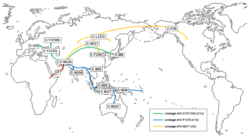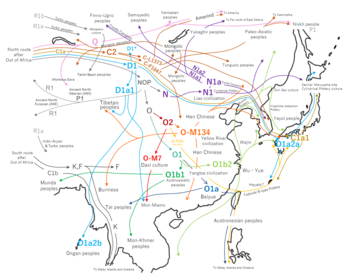Biology:Haplogroup C-M8
| Haplogroup C-M8 (C1a1) | |
|---|---|
 Migration route of Haplogroup C | |
| Possible time of origin | 41,900YBP[1] 51,800YBP[2] |
| Coalescence age | 11,650YBP[3] |
| Possible place of origin | southeast Asia[4] |
| Ancestor | (Grandparent) Haplogroup C1a |
| Defining mutations | M8, M105, M131, P122 |
| Highest frequencies | Jōmon people, Japanese people |
Haplogroup C-M8 also known as Haplogroup C1a1 is a Y-chromosome haplogroup. It is one of two branches of Haplogroup C1a, one of the descendants of Haplogroup C-M130.
It has been found in about 6% (2.3% to 16.7%) of modern males sampled in Japan and has been considered to be a Y-DNA haplogroup descended from Jōmon people.[5][6] Elsewhere, it has been observed among academic studies only in one individual in a sample collected on Jeju Island of South Korea[7] and in commercial testing in one individual who has reported an origin in Liaoning province of China and one individual who has reported an origin in Seoul, South Korea.[8]
The MRCA with its sister haplogroup C-V20 dates back to 40,000[1] to 50,000[2] years ago. Diffusion of existing subtypes of C-M8 is estimated to have begun about 12,000 years ago.[3]
C1a1 is found in the Jōmon people and are linked to the Jomon people who came from the south route.
Frequency in Japan
Frequency in samples of Japanese from various regions:[6]
- Okinawa 9.0% (4.4%[9] - 16.7%[10])[11]
- Kagawa? 8.5%[12]
- Tokyo 7.1%[2]
- Miyazaki 6.5% (0/29 = 0% Misato to 2/8 = 25% Aya, or 28/291 = 9.6% Western Miyazaki, 22/349 = 6.3% Northern Miyazaki, 27/488 = 5.5% Central Miyazaki, 6/141 = 4.3% Southern Miyazaki)[13]
- Tokushima 6.3% (5.7%[14] - 10.0%[3])
- Osaka 6.2%[6]
- Fukuoka 5.9%[14]
- Kawasaki 5.6%[14]
- Shizuoka 4.9%[3]
- Sapporo 4.1% (3.4%[14] - 4.6%[14])
- Kanazawa 4.0% (3.4%[14] - 4.7%[14])
- Aomori 3.8% (2.5%[10] - 7.7%[3])
- Nagasaki 3.3%[14]
- Saga 2.3%[10]
History
Haplogroup C1a1 (M8) is mostly unique to the Japanese archipelago, and its migration route is enigmatic.
C1a1 is estimated to be one of the common haplogroups among the Jōmon people (about 30% or more), next to D1a2a, D1a1, C2, K, and F.[15]
References
- ↑ 1.0 1.1 Zhong H, Shi H, Qi XB et al. (July 2010). "Global distribution of Y-chromosome haplogroup C-M130 reveals the prehistoric migration routes of African exodus and early settlement in East Asia". J. Hum. Genet. 55 (7): 428–35. doi:10.1038/jhg.2010.40. PMID 20448651.
- ↑ 2.0 2.1 2.2 G. David Poznik, Yali Xue, Fernando L. Mendez, et al., "Punctuated bursts in human male demography inferred from 1,244 worldwide Y-chromosome sequences." Nature Genetics 2016 June ; 48(6): 593–599. doi:10.1038/ng.3559.
- ↑ 3.0 3.1 3.2 3.3 3.4 Hammer MF, Karafet TM, Park H et al. (2006). "Dual origins of the Japanese: common ground for hunter-gatherer and farmer Y chromosomes". J. Hum. Genet. 51 (1): 47–58. doi:10.1007/s10038-005-0322-0. PMID 16328082.
- ↑ "FamilyTreeDNA - Genetic Testing for Ancestry, Family History & Genealogy". https://www.familytreedna.com/public/y-dna-haplotree/C;name=C-M105.
- ↑ Michael F Hammer; Tatiana M Karafet; Hwayong Park; Keiichi Omoto; Shinji Harihara; Mark Stoneking; Satoshi Horai (2006). “Dual origins of the Japanese: common ground for hunter-gatherer and farmer Y chromosomes”. Journal of Human Genetics 51 (1): 47 - 58. doi:10.1007/s10038-005-0322-0. PMID 16328082.
- ↑ 6.0 6.1 6.2 Nakahori, Yutaka; Iwamoto, Teruaki; Yamauchi, Aiko; Ewis, Ashraf A.; Shinka, Toshikatsu; Sato, Youichi (2014). "Overview of genetic variation in the Y chromosome of modern Japanese males" (in en). Anthropological Science 122 (3): 131–136. doi:10.1537/ase.140709. ISSN 0918-7960. https://www.jstage.jst.go.jp/article/ase/122/3/122_140709/_html/-char/en.
- ↑ Kim, Soon-Hee; Kim, Ki-Cheol; Shin, Dong-Jik; Jin, Han-Jun; Kwak, Kyoung-Don; Han, Myun-Soo; Song, Joon-Myong; Kim, Won et al. (2011). "High frequencies of Y-chromosome haplogroup O2b-SRY465 lineages in Korea: A genetic perspective on the peopling of Korea". Investigative Genetics 2 (1): 10. doi:10.1186/2041-2223-2-10. PMID 21463511.
- ↑ YFull Haplogroup YTree v6.02 at 02 April 2018
- ↑ Tajima, Atsushi; Hayami, Masanori; Tokunaga, Katsushi; Juji, T; Matsuo, M; Marzuki, S; Omoto, K; Horai, S (2004). "Genetic origins of the Ainu inferred from combined DNA analyses of maternal and paternal lineages". Journal of Human Genetics 49 (4): 187–193. doi:10.1007/s10038-004-0131-x. PMID 14997363.
- ↑ 10.0 10.1 10.2 Shoji Totsuka, The Super Science High School Consortium, Youichi Sato, and Masashi Tanaka, "A study of the geographic distribution of Y chromosomal and mitochondrial DNA haplogroups in Japanese population by Super Science High School Consortium (SSH)." Anthropological Science (Japanese Series) Vol. 124(2), 85–91, 2016.
- ↑ Nonaka I, Minaguchi K, Takezaki N (July 2007). "Y-chromosomal binary haplogroups in the Japanese population and their relationship to 16 Y-STR polymorphisms". Ann. Hum. Genet. 71 (Pt 4): 480–95. doi:10.1111/j.1469-1809.2006.00343.x. PMID 17274803.
- ↑ Yali Xue, Tatiana Zerjal, Weidong Bao, Suling Zhu, Qunfang Shu, Jiujin Xu, Ruofu Du, Songbin Fu, Pu Li, Matthew E. Hurles, Huanming Yang, and Chris Tyler-Smith, "Male Demography in East Asia: A North–South Contrast in Human Population Expansion Times." Genetics 172: 2431–2439 (April 2006). DOI: 10.1534/genetics.105.054270
- ↑ Hirofumi Nohara, Ikuko Maeda, Rinnosuke Hisazumi, Taketo Uchiyama, Hiroko Hirashima, Masahito Nakata, Ohno Rika, Tetsuro Hasegawa, and Kenshi Shimizu, "Geographic distribution of Y-STR haplotypes and Y-haplogroups among Miyazaki Prefecture residents." Japanese Journal of Forensic Science and Technology, Volume 26 (2021), No. 1., p. 17-27. https://doi.org/10.3408/jafst.778
- ↑ 14.0 14.1 14.2 14.3 14.4 14.5 14.6 14.7 Youichi Sato, Toshikatsu Shinka, Ashraf A. Ewis, Aiko Yamauchi, Teruaki Iwamoto, and Yutaka Nakahori, "Overview of genetic variation in the Y chromosome of modern Japanese males." Anthropological Science Vol. 122(3), 131–136, 2014. doi:10.1537/ase.140709
- ↑ Ohashi, Jun; Tokunaga, Katsushi; Hitomi, Yuki; Sawai, Hiromi; Khor, Seik-Soon; Naka, Izumi; Watanabe, Yusuke (2019-06-17). "Analysis of whole Y-chromosome sequences reveals the Japanese population history in the Jomon period" (in en). Scientific Reports 9 (1): 8556. doi:10.1038/s41598-019-44473-z. ISSN 2045-2322. PMID 31209235. Bibcode: 2019NatSR...9.8556W.
 |


